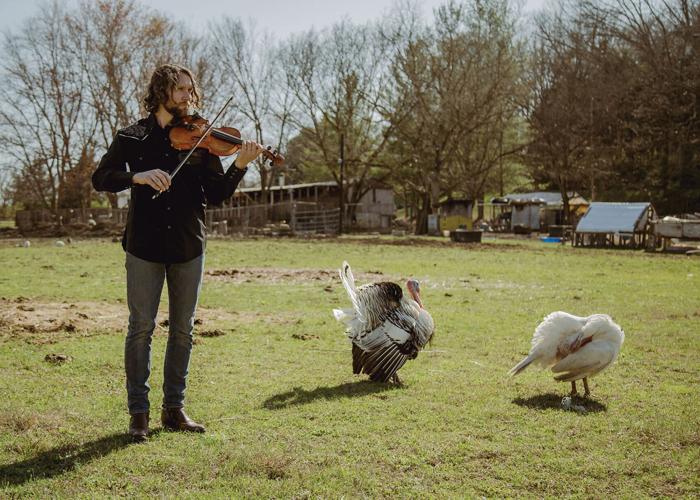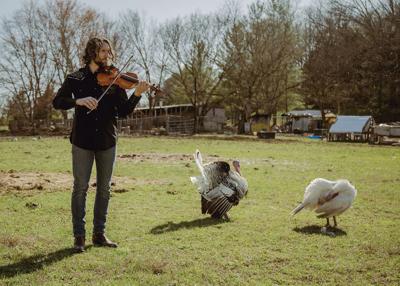On hearing George Jackson play a fiddle tune from his new record Hair & Hide, you might think he’d lived in Appalachia all his life. In fact, the New Zealand-born fiddler and composer made his way to Nashville just five years ago.
Jackson graduated from the International Bluegrass Music Association’s Leadership Bluegrass program, and later he performed in the IBMA’s official 2019 showcase concert. Seven banjoists take turns accompanying him on Hair & Hide, which is out Oct. 29. Each plays on one traditional tune and one original among the 14 tracks. Jackson connected with many of these pickers through the IBMA, and others through the nonprofit Bluegrass Pride.
Without prior knowledge, it’s hard to distinguish between the new tunes and their traditional counterparts, and that’s exactly how Jackson likes it. The opening piece “Mississippi Sawyer,” a traditional tune that features banjo picker and teacher Wes Corbett, is one exception that sounds decidedly old-school. The lively tune is built for buck dancing, and sounds like waiting on the porch of the cabin while supper’s cooking — filled with Jackson’s intricate bowing, trills and runs up the neck of the unfretted instrument. He also keeps time during Corbett’s solos with bow chopping, adding a bit of percussion to moments that might otherwise be a little quiet with only two instruments in the mix.
“I was going through a bunch of different versions I found by two fiddlers from West Virginia,” Jackson says of the tune. “I took a part from this fiddler and a part [from the other]. It’s new, but an old West Virginia chestnut as well.”
Near the end of the album, Jackson plays “Smoky Hole” with 14-year-old Uma Peters, a young talent who’s been a standout in the bluegrass world for some time now in a duo with her brother Giri. Originally written by Black fiddler Will Adams, “Smoky Hole” is a slower tune with a bit of an Appalachian Gothic sound; you hear Jackson doubling his bow strings for a deeper resonance. He notes that the piece was a perfect fit, offering an opportunity to open up the discussion about the critical roles of Black musicians in the string-band tradition and to shed light on a lesser-heard tune.
Peters meanwhile picks with an old-timey style influenced by her mentor, string-band scholar and Carolina Chocolate Drops founding member Rhiannon Giddens. She says that for a while, she was playing Giddens’ traditional gourd banjo. It was important to her to play a tune similar to the ones she learned during an internship with the Tennessee Arts Commission.
“I was learning all the really old tunes from Africa, what slaves played, and what they would play when they were brought here to America,” Peters says. “That was very eye-opening for me, because I really learned a lot about where this music originated from.”
The original the pair played together is “Turtle Rock,” a near-lullaby-soft, slow tune that features a syncopated beat; it’s easy to imagine serenading turtles as they sun themselves on a rock jutting out of a pond. Jackson says that while some of the original tunes weren’t necessarily written for any particular banjoist, he wanted to create something groovy for Peters and followed the kinds of melodies she already likes to play. “Turtle Rock” was the result.

Jackson also worked with Brad Kolodner, an IBMA board member and clawhammer banjoist in Baltimore roots band Charm City Junction. Kolodner, who has been playing clawhammer banjo since he was 17, says he grew up in a musical family with a father who played hammer dulcimer. Kolodner and Jackson first met at an old-time fiddle convention in West Virginia, where the two really hit it off.
“We just hung out playing tunes, enjoyed the chemistry we had musically,” Kolodner recalls. “[Jackson is] such a great fiddler, and we would seek each other out.”
The pair worked well together on Jackson’s previous album, a 2019 collection of pieces for a full bluegrass ensemble titled Time and Place. Jackson pitched Kolodner on the idea of a record that mixed original and old tunes, and after they performed together at Nashville bluegrass mecca the Station Inn in February 2020, Kolodner was ready to dive in. They recorded Jackson’s own “Neighbor Mike” and the classic “Ida Red” together for what eventually became Hair & Hide.
“Ida Red” is another hoedown staple, and the smoothness of Jackson’s playing despite the fast tempo of the song could easily be mistaken for a fiddling legend like Kenny Baker. There are lots of instances of a tricky fiddle maneuver called a double stop, and Kolodner does a catchy descending run down the neck of the banjo that sounds like what you’d expect a bass to play.
Jackson says it’s hard to pinpoint particular goals for the record. But he does remember magical moments following the release of Time and Place in which he’d find fans or friends playing his own tunes back to him. He hopes for more of those moments soon.
“I never want to expect that that would happen again, but it would be really fulfilling to hope some people would be interested in playing some tunes. Whether it’s tunes I wrote or chose to put on the album. I love hearing that stuff come back to you.”







